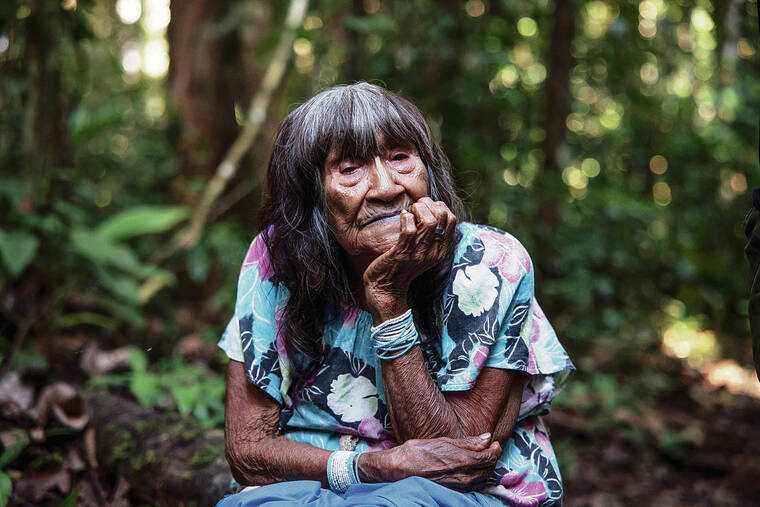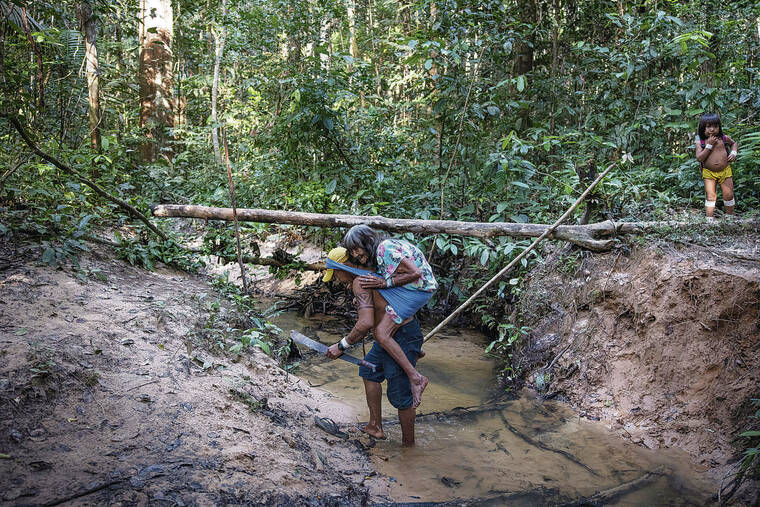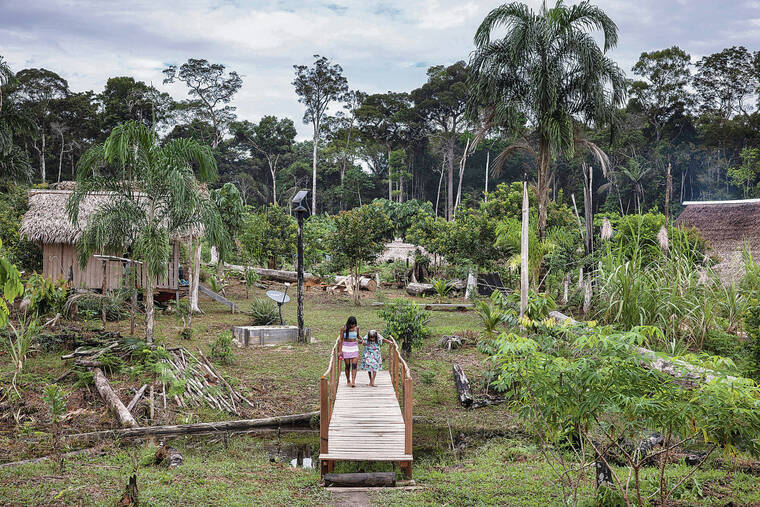Oldest member of Marubo tribe has helped preserve their culture and customs

VICTOR MORIYAMA/THE NEW YORK TIMES
Vari Vati Marubo, who is likely one of the oldest people still living deep in the Amazon rainforest, in the Marubo Indigenous Territory in the Acre state of Brazil, April 9, 2024. The life of Marubo shows how much life has changed for the rainforest’s Indigenous tribes — and how much has stayed the same.

VICTOR MORIYAMA / NEW YORK TIMES / APRIL 9
Tama Txano Marubo carries his mother, Vari Vati Marubo, on his back across 13 miles of rainforest in the Marubo Indigenous Territory of Brazil.

VICTOR MORIYAMA/THE NEW YORK TIMES
Vari Vati Marubo, who is likely one of the oldest people still living deep in the Amazon rainforest, is helped across a bridge in the Marubo Indigenous Territory in the Acre state of Brazil, April 7, 2024. The life of Marubo shows how much life has changed for the rainforest’s Indigenous tribes — and how much has stayed the same.



JAVARI VALLEY INDIGENOUS TERRITORY, Brazil >> After more than 100 years in the rainforest, Vari Vati Marubo walks with a stick and, as she always has, barefoot.
So when her Indigenous tribe, the Marubo, gathered for meetings this year in a village that would require a 13-mile hike across streams, fallen logs and dense forest to reach, everyone knew it would be difficult for her to attend.
But, as she has for a century, Vari Vati dealt with the elements. She caught a ride on the only transportation available: her son’s back.
“Be careful with me!” she shrieked to her son, Tama Txano Marubo (all Marubo use the same surname), as he climbed down a muddy embankment with a machete in one hand and his mother on his back. Her weight sat on a blue strip of fabric that stretched tight across his forehead. “Call a truck to come get me!” she shouted to laughing relatives. “This is too much.”
She made it just fine.
Beyond being the senior elder in the 2,000-member Marubo tribe, Vari Vati is likely one of the oldest people still living deep in the Amazon rainforest. Her official government document, based on an estimate from an anthropologist, says she turns 107 in September, though her family believes she is even older. Fellow tribe members describe her as over 120.
Don't miss out on what's happening!
Stay in touch with breaking news, as it happens, conveniently in your email inbox. It's FREE!
Maria Lucimar Pereira Kaxinawa of the nearby Huni Kuin people was 131 when she died in 2022, according to a government document. If that age was accurate, she would have been the oldest person in the world. Researchers have attributed the longevity of some Indigenous people in the Amazon, despite the sometimes harsh environment, to their active lifestyles and natural diets.
Vari Vati is part of a seasoned group of Indigenous elders who have helped preserve their people’s culture and customs in the face of tremendous change and challenges inside and outside their forest home.
The arc of her life has tracked a century of transformation for the Amazon’s Indigenous people, when many have confronted new contact with outsiders and their technology, as well as vast destruction of the jungle.
And yet her day-to-day routine shows how some Indigenous groups have been able to preserve a way of life that still resembles that of their ancestors.
Vari Vati has spent all her life in one of the most isolated stretches of the planet, surrounded by miles of forest in every direction. She has slept in a hammock in a “maloca,” a 50-foot-tall communal hut where the Marubo cook, eat and sleep together.
She has crafted jewelry and clothes out of material from the forest, including cotton, seeds and animal teeth. And she has cooked traditional dishes over a fire, including banana porridge, roast lizard and fish roe wrapped in banana leaves.
Vari Vati also remembers a time as a child when seeing a white person could send her people running to hide. But now an increasing number of Marubo live outside the forest. They speak and study in Portuguese, and some have become lawyers and engineers, activists and academics. The latest Marubo generation — connected in their remote villages via Elon Musk’s Starlink internet service — are on TikTok.
“Since our birth we’ve kept the traditions alive. But now I see everything changing,” Vari Vati said in her native language, spoken by just a few thousand people. “Many young people have forgotten the wisdom of our elders.”
She said she understands the search for new knowledge but also worries that migration to the city could erase the culture bred in her tribe’s forest villages. “I like being in the forest, being at peace and in harmony,” she said. “Waking up to the dawn breeze, catching the tasty fish. All of this makes me feel alive.”
The Marubo first made contact with outsiders near the end of the 19th century when rubber tappers pushed into their section of the Brazilian Amazon, near the border with Peru. “When we saw white people, we were very afraid,” Vari Vati said. “Our medicines only cured our diseases, not unknown diseases from the outside.”
Many Marubo died — from disease and violence. Vari Vati likely was in her 20s during World War II, but when asked, she had never heard of it. “The only war I witnessed was that of the Peruvians against the Indigenous people,” she said.
Vari Vati, a daughter of the Marubo’s past chief, married three times and had nine children, the oldest of whom is now believed to be nearly 90. Her first husband left her. Her second was murdered, her family said. And her third later married her niece and now lives in a different village. (In Marubo culture, men are allowed to marry multiple women; women may marry only one man.)
The Marubo live collectively, with everyone in a village pitching in with different responsibilities, from farming, hunting, cooking and cleaning, and everyone eating the same food from the same bowls.
There are also clear gender roles — and privileges. The men hunt and the women cook. The men eat with forks and spoons at one end of the maloca, sitting on logs. The women eat with their hands at the other, sitting on mats woven from palm fronds. The men take ayahuasca, a psychedelic brew made from an Amazonian plant, to connect with spirits; the woman may not.
Several Marubo lamented the inequality. Vari Vati suggested it was how life was. Still, the tribe recently elected its first woman as part of the leadership and is now starting its first women’s association.
At the meetings this year, part of periodic tribal gatherings to resolve problems and discuss new plans, Vari Vati rose to speak. Nearly everyone stopped to listen.
“Let us not focus on conflicts or hate, but on a collective good, on what is best for our people, on living in peace and harmony,” she said, holding on to her son for support. “We are Indigenous. We can’t live like the non-Indigenous people.”
She added that she was happy she had the chance to address the tribe. “I won’t always be here,” she said. “And I’m fearful you will be lost in the future.”
On the way back from the meetings, Vari Vati and her family stopped to rest. She sat on a log, crouched over, her head in her hand. She swatted at flies circling a cut in her foot.
Her son, Sebastiao, who lives part time in the city, said he tries to encourage his mother to take better care of herself, including by wearing flip-flops and taking more Western medicine. But she resists.
“She’s always saying, ‘Who cares for us is the forest,’” he said, “‘the spirits of the forest. We don’t need to worry.’”
This article originally appeared in The New York Times Opens in a new tab.
© 2024 The New York Times Company




